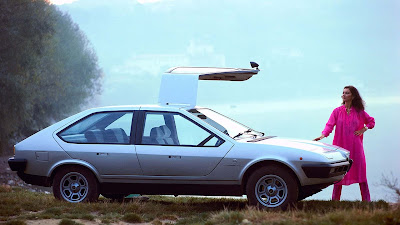Out of The BOX - In the ever-evolving landscape of technological innovation, Opel and Blitz surprised the automotive world with an alternative concept vehicle that defies gravity—literally. Responding to the burgeoning interest in space tourism, Opel unveiled their ambitious project in April 2023—a vehicle designed for lunar tourism, aptly named the Opel Corsa Moon II.
 |
| Opel unveiled their ambitious project in April 2023—a vehicle designed for lunar tourism, aptly named the Opel Corsa Moon II. (Picture from: ActualidadMotor) |
The brainchild of Opel's parent company, Stellantis, the Corsa Moon II promises to be the first mode of transportation for lunar tourists, should such ventures become a reality. What sets this concept vehicle apart is its integration of cutting-edge space-age technology, a testament to the rapid advancements in the automotive industry.
Drawing inspiration from Opel's best-selling electric car, the Corsa-e, the Corsa Moon II boasts a 500 kWh battery powered by state-of-the-art solar panel technology. These solar panels, reminiscent of the Corsa Moon concept from 1997, enable the vehicle to cover an impressive 7,000 km in the Universe-wide Harmonized Light-duty Vehicle Test Procedure (ULTP) cycle on a single charge.
 |
| To tackle the rugged lunar terrain, the Opel Corsa Moon II features an elevated chassis that provides ample ground clearance. (Picture from: ActualidadMotor) |
One of the standout features of the Corsa Moon II is its Intelli-Lux® laser light system. Positioned at the front, this laser light is said to illuminate surfaces on the Moon with a strength 1,000 times greater than traditional LED technology, all while consuming only a fraction of the power. The heightened precision and faster reaction time of this laser light ensure optimal visibility on the lunar surface, a crucial factor for safe lunar exploration.
 |
| The Opel Corsa Moon II drawing inspiration from Opel's best-selling electric car, the Corsa-e. (Picture from: Stellantis) |
Opel's commitment to innovation doesn't stop there. The Corsa Moon II boasts a set of airtight and durable space tires, a groundbreaking addition to the space tourism concept. Crafted from highly elastic and robust nickel-titanium material, these woven wheels promise excellent grip on extraterrestrial surfaces and, more impressively, are designed never to leak.
To tackle the rugged lunar terrain, the Corsa Moon II features an elevated chassis that provides ample ground clearance. While details about the body and rims' materials remain undisclosed, Opel emphasizes their strength, durability, and elasticity—critical factors ensuring reliable traction on the Moon's surface.
 |
| Back in 1997, Opel had already showcased the Corsa Moon, marking a prior instance of their conceptualization for a Moon-operating vehicle. (Picture from: ActualidadMotor) |
 Quentin Huber, Head of Brand Marketing at Opel, expressed the company's vision, stating, "With our revolutionary Opel Corsa Moon II, we are once again crossing new frontiers and focusing on sustainable mobility solutions. The Corsa Moon development project aims to take Moon exploration as a significant step towards the ultimate goal of a long-term presence on the Moon."
Quentin Huber, Head of Brand Marketing at Opel, expressed the company's vision, stating, "With our revolutionary Opel Corsa Moon II, we are once again crossing new frontiers and focusing on sustainable mobility solutions. The Corsa Moon development project aims to take Moon exploration as a significant step towards the ultimate goal of a long-term presence on the Moon."Now, as you marvel at the possibilities of this lunar marvel, it's crucial to unveil the truth behind the spectacle. This does feel like something is not right and raises a lot of questions. If you're still questioning the feasibility of Opel's lunar venture, you're not alone.*** [EKA | FROM VARIOUS SOURCES | STELLANTIS | OPEL POST | ACTUALIDADMOTOR ]
Note: This blog can be accessed via your smart phone.







































